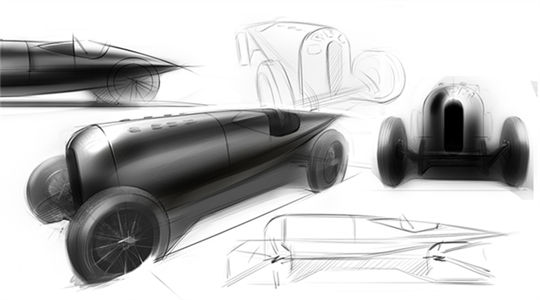
当前课程知识点:Production Engineering > Chapter 5 Gas Lift > 5.3 Gas Lift Design > 5.3.4 Design Depths of Unloading Valves
返回《Production Engineering》慕课在线视频课程列表
返回《Production Engineering》慕课在线视频列表
同学们好
本节我们介绍利用图示法
进行启动阀设计的方法
这是一个设计的图版
纵轴是不同的井的深度 横轴是压力
首先
这条线是对应油井深度的一条线
这条线对应的是地层压力
以这个点为起点的静液柱的压力梯度线
这根蓝色的线表达的是
环空内注入压力的分布线
这是井口的注入压力
随着不同的深度环空内的压力分布
这根绿色的线表达的是
井底的流动压力情况之下它的压力分布的线
要注意的是
这条线是没有气体注入的情况之下
纯液流情况
它的压力分布线
同学们要注意的是
这个压力梯度跟静液柱的压力梯度相比
比较接近但是略有不同
考虑到了流动的摩擦阻力等等的影响
第四条线
这条线表达的是什么
是注入了气体之后
我们期望在井筒内它的压力梯度减少
是我们期望的一种结果
那么这个结果就是指定的井口压力
掺入气体之后井筒内的压力分布
是这样的一个分布状态
以上就是我们利用图示法
进行启动阀设计的一个基础的准备工作
做了这样的一些工作之后
我们要做的一件事情
大家注意
是要经过井口压力做一条平行的斜线
跟谁平行
跟静液柱的这条线平行做一条斜线
跟环空内的环空压力线相交得到一个交点
得到一个交点
那么这个交点我们就认为是
第一级启动阀的下入位置
我们来回想一下
这个交点的位置
它所支持的纯液柱高度是多少
就是根据这个静液柱的压力梯度
这根线表达的这段深度
换句话说
就是压缩机能够提供的最大的输出压力
所能支撑得多长的一段静液柱
就是这段静液柱
这个时候液面已经不能够再继续下移了
我们就需要加入第一级的启动阀了
因此这个点我们称为第一级启动阀的下入位置
下入了这一级启动阀之后
我们来看一下它的压力状态
环空内的压力在这
而油管内的压力在这个位置
为什么这么讲
大家还记得这条线是注入了气体之后
油管内的压力分布线
那么在这个深度上它的压力显然是在这个位置
启动阀的外侧这个压力
内部这个压力
中间有了一个压力差
而这个压力差我们就需要第二级的启动阀
来抵消这样一段压力
怎么来做的
要注意的图示法
第二步
就是采用这样的一个平行线
来得到新的一级
在新的一级启动阀的位置确定之前
我们需要进行温度的修正
那么这个温度修正
就是根据环空内的油管内的温度分布
计算流体的物性参数来得到它的修正结果
得到了修正结果之后
我们看是根据这个交点继续做平行线
还是做的静液柱压力梯度的平行线
跟环空内的压力又有了一个新的交点
那么这样的一个交点就是
第二级阀所处于的位置
当然我们看到了因为这个阀的加入
使得阀的外部和内部又有了一个△P
那么这个△P就是富余的压力
需要再将液面下移
用一段纯液柱去支撑这段富余的压力
依次类推
我们可以做出
第三级
第四级
第五级的启动阀
那么通过刚才的这种图示法
我们可以看到的规律
就是每一级启动阀的位置
就是每一级启动阀的位置
它的间隔
相互之间的间隔是越来越小的
为什么
规律就是下一级的启动阀的下入深度
总是跟上一级的启动阀内外压差相关的
而这个内外压差是越来越小的
所以启动阀的位置
它之间的间隔是越来越小的
直到什么时候为止
直到启动阀将液面压入到了
我们规定的设计的工作阀的位置
我们设计的工作阀的深度
启动阀的设计过程就结束了
以上就是我们介绍的利用图示法
进行启动阀位置设计的方法
同学们再见
-1.1 Main Tasks of Production Engineering
--1.1 Main Tasks of Production Engineering
-1.2 Flow in Production System
--1.2 Flow in Production System
-Problems
--Chapter 1 - Problems
-2.1 IPR Curve and Well Productivity
--2.1.1 Single-Phase Oil Inflow Performance Relationships
-2.2 Vogel's IPR and Applications
--2.2.2 Determination of IPR Curves Using Vogel's Equation
--2.2.3 Skin Factor and Flow Efficiency
--2.2.4 Extension of Vogel's Equation for Non-Complete Wells
--2.2.5 Combination Single-Phase Liquid and Two-Phase Flow
-Problems
--Chapter 2--Problems
-3.1 Two-Phase Flow in Wellbore
--3.1.1 Flow Regimes in Vertical Flow
-3.2 Two-Phase Vertical Flow Pressure Gradient Models
--3.2.1 Two-Phase Pressure Gradient Equations
--3.2.2 Predicting Gas-Liquid Flow Regimes Using the Okiszewski Correlation
--3.2.3 Pressure Gradient Calculation Using the Okiszewski Correlation
-3.3 Vertical Lift Performance
--3.3 Vertical Lift Performance
-Problems
--Chapter 3--Problems
-4.1 Nodal Analysis Approach
--4.1.2 Solution Node at Bottom of Well
--4.1.3 Solution Node at Wellhead
-4.2 Flow through Chokes
--4.2.2 Solution Node at Choke
-Problems
--Chapter 4--Problems
-5.1 Principles of Gas Lift
--5.1.2 Initial Kick-off of Gas Lift
-5.2 Gas Lift Valves and Gas Lift Completions
-5.3 Gas Lift Design
--5.3.1 Gas Lift Design for Specific Production Rate
--5.3.2 Gas Lift Design for Specific Injection Rate
--5.3.3 Kick-off Procedure with Unloading Valves
--5.3.4 Design Depths of Unloading Valves
-Problems
--Chapter 5--Problems
-6.1 Introduction of Surface and Downhole Equipment
-6.2 Operating Principle of Sucker Rod Pumps
-6.3 Pumping Unit Kinematics
--6.3.1 Motion of Polished Rod-Simple Harmonic Motion
--6.3.2 Motion of Polished Rod-Crank and Pitman Motion
-6.4 Polished Rod Load
--6.4.3 Peak Polished Rod Load and Minimum Polished Rod Load
-Problems
--Problems for chapter 6: Sucker Rod pumping I
-6.5 Calculation of Counterbalancing, Torque and Power
--6.5.1 Balance of Pumping Unit
--6.5.2 Counterbalancing Calculation
--6.5.3 Torque and Torque Factor
-6.6 Volumetric Efficiency of Pump
--6.6.2 Gas Effect on Pump Performance
--6.6.3 Measures of Enhancing Pump Volumetric Efficiency
-6.7 Design of Pumping System
--6.7.1 Strength Calculation and Design of Sucker Rod Strings
--6.7.2 Design Procedures of Pumping System
-6.8 Analysis of Sucker Rod Pumping Well Conditions
--6.8.1 Acoustic Surveys and Analysis of Annular Liquid Levels
--6.8.2 Introduction of Dynamometer Card
--6.8.3 Typical Dynamometer Cards
-Problems
--Problems: Chapter 6: Sucker Rod Pumping (II)
-7.1 Water Injection System
--7.1.1 Water Resources and Water Treatment
--7.1.2 Introduction of Water Injection System
-7.2 Injectivity Analysis
--7.2.1 Injectivity and Injectivity Index Curves
-7.3 Injection Tubing String
--7.3 Introduction of Injection Tubing Strings
-7.4 Analysis and Application of Injectivity Index Curves
--7.4.1 Analysis of Injectivity Index Curves
--7.4.2 Injection Choke Deployment
-Problems
--Chapter 7--Problems
-8.0 Introduction
-8.1 The Fracturing of Reservoir Rock
--8.1.1 Basic Rock Mechanics Parameters
--8.1.4 Fracture Initiation Conditions
-Problems
--Chapter 8(I)--Problems
-8.2 Fracturing Fluids
--8.2.2 Fluid-Loss Properties of Fracturing Fluids
--8.2.3 Rheological Properties of Fracturing Fluids
-8.3 Proppants
-8.4 Hydraulic Fracturing Design
--8.4.1 Productivity Index of Hydraulic Fracturing Wells
--8.4.2 Fracture Geometry Models
--8.4.3 Design Procedure for Hydraulic Fracturing
-Problems
--Chapter 8(II)--Problems
-9.0 Introduction
-9.1 Carbonate Acidizing
--9.1.1 Mechanism of Carbonate Acidizing
--9.1.2 Effect Factors of Reaction Rate
--9.1.4 Effective Distance of Live Acid
-9.2 Sandstone Acidizing
--9.2.1 Mechanism of Sandstone Acidizing
--9.2.2 Mud Acid Treatment Design
-9.3 Acidizing Treatment Technologies
--9.3.2 Acidizing Treatment Operations
-Problems
--Chapter 9--Problems
-Final Exam
